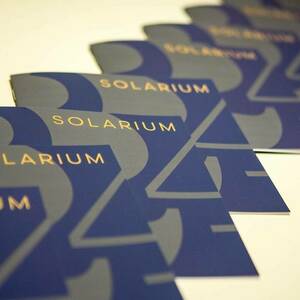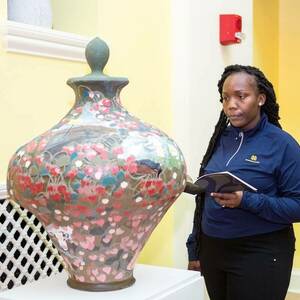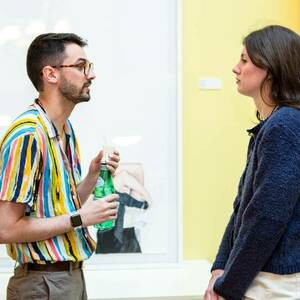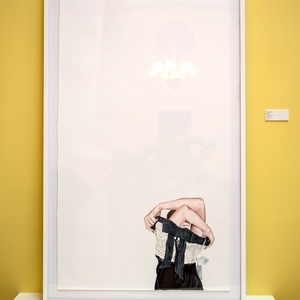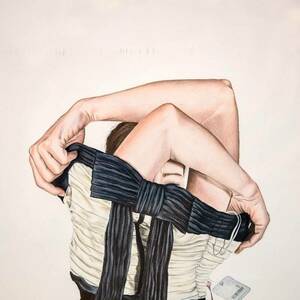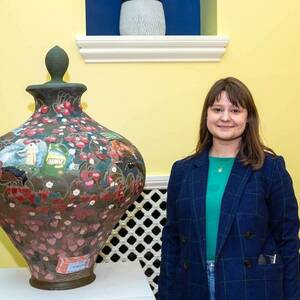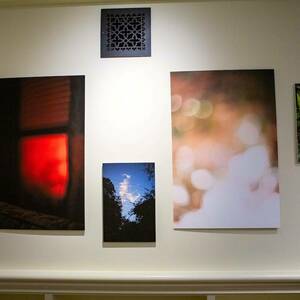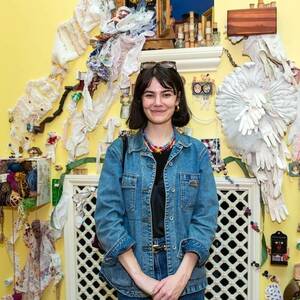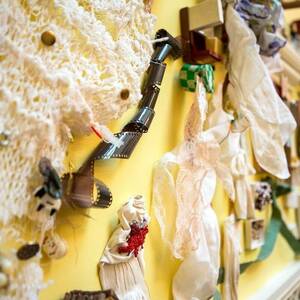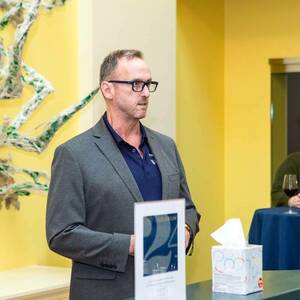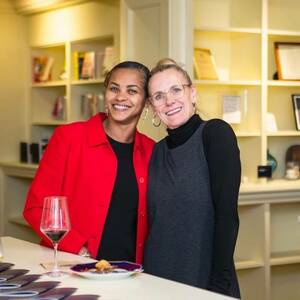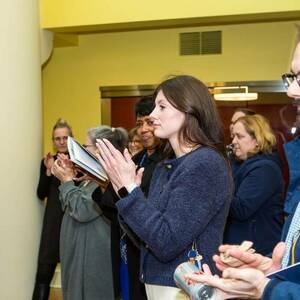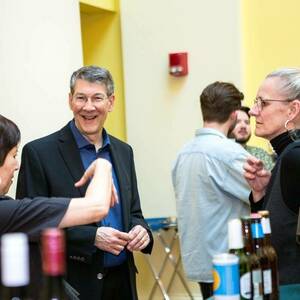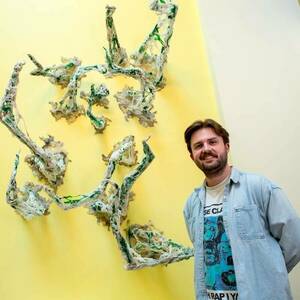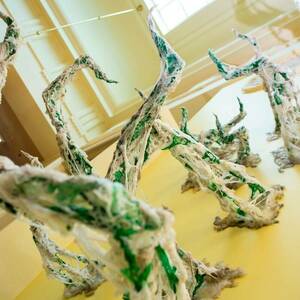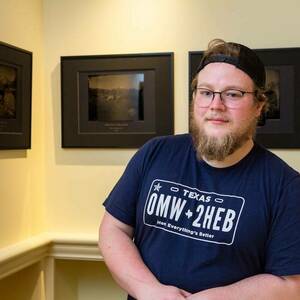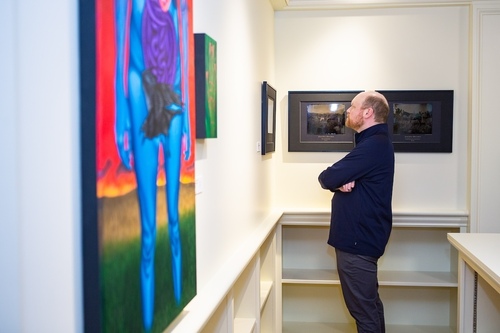
In what has become a spring semester tradition, the Graduate School’s light-filled suite of offices in Bond Hall is once again a gallery space displaying the works of talented Notre Dame master of fine arts (MFA) students in the Department of Art, Art History, and Design.
For the students, the works on view in the Solarium 24 show are individual artistic expressions derived from years refining the skills important to their particular creative process—whether that be drawing, painting, sculpture, or photography.
And, as with all visual artistic expression, there is both what we see and what lies beneath.
“Within the context of a research university, art is an intellectual pursuit as well as a visual one,” says Jason Lahr, associate professor, painting and drawing, and director of graduate studies for the MFA programs in studio art and design. “The art is how our MFA students engage with the world. The way we articulate our research is through form, materials, images, and objects.”
The works on display this year reveal some of the troublesome issues of contemporary life with which the students are engaged. Those issues include our deteriorating environment, the experience of anxiety and how one might confront or escape it, the pressure exerted on women to both perform and conform, and how we choose to remain—or not—connected to our families and our past.
The seven MFA students in the 2024 juried show:
- Franceska Alvarado—Painting
- Norah Amstutz—Ceramics/Pottery
- Thomas Callahan—Photography
- Lily Dorian—Sculpture
- Riley Fichter—Sculpture
- Joseph Matty—Photography
- Emma Ryan—Painting
Alvarado, Amstutz, and Dorian claim awards
At the opening reception on Wednesday, March 6, Michael Hildreth, Ph.D., dean of the Graduate School; associate provost and vice president for graduate studies; and professor, Department of Physics and Astronomy, welcomed the artists and visitors. He announced three awards, each conveying not only recognition and honor, but a $1,000 prize:
Best Artist Award: Franceska Alvarado
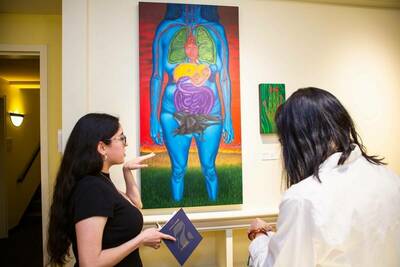
“Above all, I intend to put my audience in a surreal atmosphere that stimulates raw emotion and blurs the threshold between imagination and reality.”
Franceska’s work explores the physical, mental, and emotional aspects of the human condition from the perspective of a young woman. That young woman is very specifically herself and, even more specifically, that self experiencing anxiety. Using a surreal lens, in the painting Storm Before the Calm, she explores how various organs feel when she is anxious—for example, the phrase “butterflies in my stomach” is given literal representation, while a raven is included as a symbol of foreboding.
Within this painting, Franceska also explores the role of peer pressure in engendering anxiety. Barely extinguished cigarettes in a lung and a writhing snake for intestines represent the uneasy feelings that arise when friends or social media promote a risky activity.
Franceska is not afraid of revealing the anxious feelings that are part of the human condition. “I deal with anxiety by personifying it. The very act of painting is therapeutic,” she says.
Her second painting in the Solarium show, Burnt Out, delves into feelings created by the constant pressure exerted on an artist to create. “What am I without my art?” is the poignant question her image of an attenuated hand explores.
People’s Choice Award: Norah Amstutz
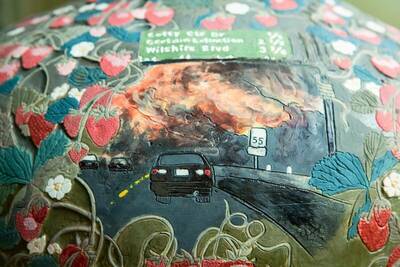
“With an urn covered with strawberries that change from gleaming red to paler red to brown, I turn a critical eye to the propaganda of accessibility that has come to define the American Dream.”
A large pot prominently featuring a curved middle to represent a swelling belly and named We Will Soon Be Rotten is Norah’s critique of the American food industry—particularly its prioritizing of profit and convenience over health.
Completed over the span of two months, every square inch of this 3 ½ ft. tall urn was hand-carved and hand-painted by the artist. Its creation springs from her passion for social justice and her experience of growing up in a rich culinary culture.
It is of utmost significance that Norah chose strawberries to cover the urn from top to bottom.
“The strawberry is a fruit that becomes ripe naturally for only a brief moment each summer; yet, it has been chemically altered to be available all year long,” she says. “In this way, we have been trained to expect access to whatever we want whenever we want it. And that has led to a decline in the nutritional value of our food, substandard wages for workers in the mega-food industry, and the near-extinction of small farms, as well as environmental calamity.”
Appearing also on the urn are seven distinct “story” images. One is a John Deere combine. Another reproduces a sign stuck on the side of a road during yet another California wildfire. It shows how many miles to both the Getty Museum and to “Certain Extinction.”
Best of Show Award: Lily Dorian

“I breathe rhythm and movement back into objects that might seem to have completed their journey. I stage a finale for them, acting as the final hand in folding them into the present.”
The installation Nothing’s Precious is an exploration of Lily’s personal inheritance. In the attic of her family home in Louisiana, she sorted through dozens of boxes of her mother’s and grandmother’s possessions—cataloging and organizing their contents. From discarded Mardi Gras beads to multiple pairs of gloves, paper dolls, embroidered handkerchiefs, ribbons, plaster architectural fragments, and even a broken clock with exposed gears—each of the objects in the installation was precious to its owner at one time.
Yes, a precious object at one time, worthy of being kept, but then essentially forgotten for decades.
“For me, these objects introduce conflicting emotions,” Lily says. “There is tension between the impulse to liberate them and an emotional tethering to precious artifacts that lay dormant.”
Lily notes that she has sought out none of the objects. They are an inheritance that, whether taken singly or together, tell a story. She is the storyteller, bringing them back into the spotlight.
How the show comes together and how it can be viewed
In addition to the students and their professors, the Solarium exhibition owes much to Aaron Bell, the Graduate School’s graphic designer and communications specialist.
All MFA studio art and design students are invited to submit art for consideration in the show, and a small contingent of judges visits the studios to select pieces. Bell connects with the students, and together they assess what might be ready for an exhibition and, given the constraints of Bond Hall, what might display well in the Solarium exhibition space.
"This show has definitely become my favorite event on our calendar each year,” says Bell. “Being an artist myself, it’s very gratifying to be able to play a role in supporting and amplifying the work of these talented artists while also having the opportunity to beautify our campus space.”
The Solarium show is located in the Graduate School offices at 117 Bond Hall. Interested members of the Notre Dame community are invited to view the exhibition during regular office hours.
